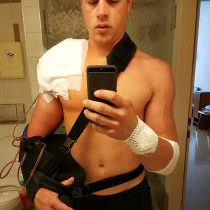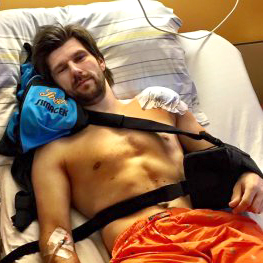DR. ULRICH LANZ, IOC Dip Sp Phy
Your shoulder specialist and shoulder surgeon in Vienna for shoulder pain and injuries
DR. ULRICH LANZ, IOC Dip Sp Phy
Your shoulder specialist and shoulder surgeon in Vienna for shoulder pain and injuries








As a shoulder specialist I will advise you competently, honestly and thoroughly about the various treatment options for shoulder pain, so we can develop a personalized therapy plan for you.
As a specialist in orthopaedics, orthopaedic surgery and sports orthopaedics, as well as a highly experienced shoulder specialist, I have developed the concept of accelerated rehabilitation, which allows you to quickly return to work, sports and daily life!
Does this sound familiar?
- Raising your arm is painful
- Severe pain keeps you from sleeping at night
- Your shoulder has been hurting for quite some time and you still don’t know why
You would like:
- to use your arm again without pain
- continue your leisure activities as before
- finally have a good night’s sleep again
In this the case, it is time to seek out a shoulder specialist! As an experienced shoulder surgeon with many years of expertise in treating shoulder pain, I will help you regain your full quality of life as quickly as possible!
3700
surgeries
18
years of supporting
elite athletes around the world
100
and publications
Shoulder pain and injuries are among the most common orthopaedic problems and can severely restrict patients’ daily routines. Shoulder injuries should never be underestimated: it is vital for the recovery process to get an accurate diagnosis quickly.
When shoulder pain affects your quality of life
Shoulder pain may affect men and women of any age and can occur as a result of illness or in the form of tendon and muscle damage resulting from injuries, chronic / repeated stress, bad posture, and degenerative joint diseases (osteoarthritis). It is not unusual for patients to feel pain in the wrist or neck and not directly in the shoulder. The pain often appears at night or during exercising or the lifting of heavier items. Patients often complain about a sharp, stabbing pain and suffer from limited mobility and a stiff shoulder. People suffering from this condition are severely restricted in their daily routines and quality of life, in general.
Shoulder joint and
shoulder pain
The shoulder connects the arm with the torso and consists of the major shoulder joint, the minor shoulder joints, and the shoulder girdle, which is made up of the scapula (shoulder blade) and clavicle (collar bone).
The main shoulder joint is the most mobile ball-and-socket joint in the human body. It is primarily held in place by muscles and tendons, rather than by bones and ligaments and, thus, can be moved along all three planes and axes.
However, this extraordinary degree of mobility also brings with it a high level of susceptibility to injury and wear-and-tear – not only in the case of athletes.
Thankfully, most shoulder pain and problems can be treated quite successfully at an early stage. However, should this phase be missed, problems may become chronic and persistent. Thus, it is essential to get the right diagnosis as soon as possible.
Shoulder pain can be divided in
acute and chronic pain:
Shoulder pain is highly uncomfortable and can severely restrict patients’ daily routines, regardless of whether the pain is acute or chronic. Even the simplest movements, such as lifting a glass, may become difficult to do.
ACUTE PAIN
Acute pain often occurs suddenly and as a result of an accident or fall, e.g. torn tendons, bone fractures or dislocations. Additionally, a calcified shoulder may also cause acute pain.
CHRONIC PAIN
Chronic pain develops slowly, over the course of time, and can be put down to incorrect positioning or movements, wear and tear, as well as repeated stress. This type of pain is persistent. One example is a calcified shoulder, which – when not diagnosed and treated in time – may develop into a very painful frozen shoulder.
TYPICAL SYMPTOMS
- Limited movement: the arm cannot be moved in all directions. In particular, lifting the arms above the head, but also smaller movements, may turn into an almost Herculean task.
- Instability: the shoulder pops out of the socket and back in again.
- Strength loss: difficulties lifting the arm.
- Tiredness during daytime as a result of pain at night.
Shoulder pain is often agonizing, long-lasting and must be taken seriously, otherwise it can lead to chronic mobility restrictions. If the problem is recognised early and diagnosed correctly, conservative therapy will help in most cases. However, should the easy treatable, early stage be overlooked, surgery might become unavoidable.

Visit a Shoulder Specialist
Early detection is the magic word when it comes to the treatment of shoulder problems, in particular for maintaining or regaining joint mobility. Therefore, it is important to visit a shoulder specialist who can identify the cause of shoulder pain fast. Once an accurate diagnosis has been made, the specialist will recommend an appropriate therapy. In most cases, shoulder problems can be treated using conservative methods, however, there are some cases in which surgery might become unavoidable.

About me
Over the course of my career, I have specialised in the treatment of the shoulder joint and have been focusing on shoulder surgery for more than 15 years. I am considered to be among Austria’s leading shoulder experts, conducting more than 3,700 shoulder surgeries. My long-term experience is also illustrated by the large number of professional athletes and musicians, who entrust me with their health.
As a longstanding, highly experienced shoulder expert, I am very familiar with the anatomy of the shoulder joint and how it works. My specialist fields are the conservative and surgical treatment of acute and chronic shoulder problems, as well as osteoarthritis. Moreover, I have an additional degree as a chirotherapist, making me proficient in hands-on therapy.










REFERENCES

Benjamin Bildstein, overall winner Sailing World Cup, after his shoulder surgery
The surgery was two weeks ago and Ben Bildstein is working constantly with a special rehabilitation on his way back! Thank to Doctor Ulrich Lanz and his team Anita Grassel, Eva Kahlbacher, Rafaela Riedel for the great and ambitious work!

Tennis player, Jürgen Melzer, after his shoulder surgery
The surgery around the labrum has been successful. Many thanks to the medical team, especially to Dr. Ulrich Lanz. The way back has started today with rehab. Also, thanks to everyone who wished me a speedy recovery. See you soon, Jürgen.
Surgery ̶ a matter of trust
Low-impact, minimally invasive surgical and conservative therapy methods, as well as interdisciplinary collaboration with experienced physiotherapists and colleagues are prioritised at my clinic. Should surgery be unavoidable as a result of your injury or worsening symptoms, I can fall back on many years of experience and a wide spectrum and large number of surgical cases to find the most gentle, least invasive surgical method for your shoulder problems.
I can also provide an artificial shoulder joint (shoulder prosthesis), should reconstructive surgery be impossible. We will use computer-aided 3D planning to fit and customise such joint perfectly for you, long before the first incision is made.
My accelerated rehabilitation methods following surgery are designed to only rest the damaged parts of the shoulder, which means that many movements can be carried out immediately. You will not have to rest the entire shoulder anymore and will be allowed to move your arm immediately. Additionally, you will receive a custom-designed, accelerated rehabilitation plan right after your surgery for optimal communication.
As a shoulder specialist, I am your expert for the following shoulder problems:
- shoulder pain
- frozen shoulder
- shoulder impingement syndrome
- calcified shoulder
- torn tendons or tendon injuries
- ruptured rotator cuff
- bone fractures
- bursitis
- dislocated shoulder and chronic instability
- osteoarthritis in the shoulder

I have many years of experience in carrying out the following surgeries:
ARTHROSCOPIC SURGERY
Only small incisions, and minimally invasive keyhole surgery are carried out using a camera and special instruments. Small incisions translate into less pain, a shorter stay at the hospital, shorter healing process and fewer scars. You will also be able to move your joint immediately afterwards thanks to the concept of accelerated rehabilitation.
- rotator cuff reconstruction
- resection arthroplasty of the AC joint
- injuries of the biceps tendon (SLAP lesion, pulley lesion, etc.)
- shoulder instability (labrum refixation / arthroscopic Latarjet, arthroscopic ICBGT)
- acute and chronic AC separation
- impingement treatment
- treatment for osteoarthritis
- frozen shoulder
- surgical nerve release
OPEN SURGERY
An approximately 10-12 cm (4-5 inches) incision. The joint is accessed without damaging the muscle tissue. The wound will be sown, as in plastic surgery, and a fine scar will remain along the natural skin folds. Immediate joint movement will be possible thanks to accelerated rehabilitation.
- artificial shoulder joint (shoulder prosthesis)
- muscle transfer surgery
- injuries of the sternoclavicular joint
- collar bone fracture
Accompanying your healing process before and after a surgery is important to me:
BEFORE YOUR SURGERY
- We will apply an infection prophylaxis individually adapted to your shoulder to minimise the infection risk
- You will receive a folder with all the important information concerning your surgery
- You will receive all the necessary prescriptions
AFTER YOUR SURGERY
- You will already learn appropriate exercises at the hospital
- You will receive a follow-up therapy plan in line with our concept of accelerated rehabilitation that is custom-designed for you to recover as quickly as possible.
It is important to me to ensure that you return to your daily routines, work and sports as quickly and pain-free as possible.
YOUR WAY OUT OF SHOULDER PAIN
1
FIRST CONSULTATION
Orthopaedic examination, checking previous medical reports, discussing the symptoms. (Additional tests, if necessary)
INDIVIDUAL TREATMENT
Therapy decision: non-surgical or surgical measures
ACCELERATED REHABILITATION
Exercises, progress checks


